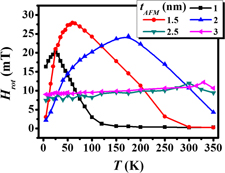Article contents
Temperature dependence of static and dynamic magnetic properties in NiFe/IrMn bilayer system
Published online by Cambridge University Press: 10 June 2014
Abstract

A systematic experimental study on the exchange bias (EB) effect in a ferromagnet/antiferromagnet bilayer system is performed both in the static (dc) and dynamic (high frequency) timescale to clarify the effects of temperature and antiferromagnetic (AFM) layer thickness on the system's stability and magnetic properties. Our system consists of NiFe/IrMn. Both parallel and perpendicular domain walls are suggested to explain the static EB and coercivity behaviors. In the microwave region, peaks, which can only be suppressed at high temperatures with strong external fields, were observed in the AFM thickness dependencies of the dynamic effective field and resonance frequency. The temperature dependence of both static and dynamic parameters suggests different values of Néel temperatures. The dynamic results show a rotatable anisotropy contribution, which has a peak value at the blocking temperature and vanishes at the dynamic Néel temperature.
- Type
- Articles
- Information
- Copyright
- Copyright © Materials Research Society 2014
References
REFERENCES
- 3
- Cited by


